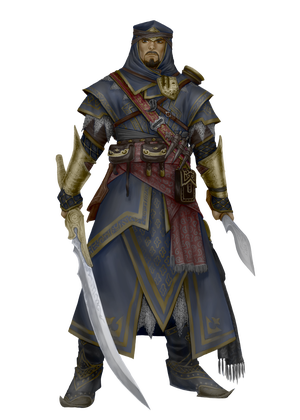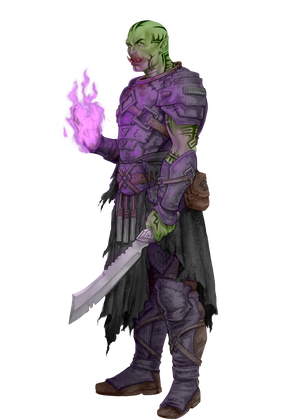Welcome! I’m Michael Sayre, the Director of Rules & Lore here at Paizo, and I’m here to talk about some of the fun and exciting stuff we’ve got coming for you in Pathfinder War of Immortals! Specifically, I’m going to talk to you about some of the new character content we’ve got coming your way.
Class archetypes have been something that have existed, at least in theory, since the beginning of Pathfinder Second Edition. These are a type of archetype that is taken at 1st level, requires you to take a specific 2nd-level feat, and often trades out some specific portion of your class features (whether adding or removing a class feature entirely, requiring you to take a specific version of a class feature, or some similar adjustment). War of Immortals introduces a new set of class archetypes to the game, so let’s dive into talking about those!

The avenger Zadim. Art by Kendal Gates.
Avenger
The first of the new class archetypes I’m going to talk about is the avenger. This class archetype for the rogue was inspired by the iconic of a Pathfinder First Edition class, the slayer. This iconic, Zadim, was a potent dual-wielding combatant who worked for a splinter branch of Sarenrae’s faith. For War of Immortals, we wanted Zadim and the avenger class archetype to be very representative of the type of rogue character who would get involved in godly affairs.
This rogue class archetype requires you to choose a deity, adjusts your starting skills, gives you a special avenger racket, and replaces the rogue’s surprise attack class feature with the Hunt Prey action. It also makes some adjustments to your sneak attack, allowing you to sneak attack with your deity’s favored weapon. Avengers excel at combatting enemy priests while wielding the favored weapons of their chosen deities, making them deadly and feared warriors during a time when gods and their servitors are at war!

The bloodrager Trzikhun. Art by Kendal Gates.
Bloodrager
In Pathfinder First Edition, the bloodrager was a class that mashed together the sorcerer and the barbarian to create a bloodline-oriented warrior with rage and limited spellcasting. We wanted to reimagine this class for Pathfinder Second Edition into something that better embodied the name and that tied more tightly into our game world, which is what we’ve done with this barbarian class archetype. With that reimagining, we brought a new character in to represent the concept: Trzikhun, Reaper of Ukuja, a Matanji orc who is part of a tradition of orcish demon-slayers who drink the blood of shadow demons to gain magical power.
Bloodragers have some modified skills and must choose the bloodrager instinct, which gives them blood rage. Blood rage allows the bloodrager to inflict persistent bleed damage while raging and applies their additional damage from rage to their spells. Their dedication feat at 2nd level gives them spellcasting and adds the rage trait to the spells they gain from this archetype while they are raging, as well as giving them the Harvest Blood action, which allows them to refresh their temporary Hit Points and boost their saving throws against the magical attacks of enemies who they have used Harvest Blood against. This ability plays into later feats like Spelldrinker, which allows them to temporarily add spells to their repertoire when using Harvest Blood based on the type of target creature, such as granting them the wall of thorns spell when they use Harvest Blood against a fey enemy!

The vindicator Imrijka. Art by Kendal Gates.
Vindicator
The final class archetype we’re going to talk about today is the vindicator class archetype, which alters the ranger class. This class archetype requires the ranger to choose a deity, is automatically trained in Religion instead of Nature, and is trained in their deity’s favored weapon, gaining deadly simplicity if that weapon’s damage dice is smaller than d6 and treating the weapon as martial for the purposes of proficiency if the weapon is advanced. They also gain a special hunter’s edge called the vindication edge and learn their warden spells as divine spells, as well as gaining the ability to select domain spells as appropriate to their deity. They gain their deity’s sanctification and have some other adjustments to class features like trackless journey and masterful hunter to make them better fit with the other changes.
This class archetype is represented by Imrijka, who was the iconic inquisitor in Pathfinder First Edition. As part of her update to Pathfinder Second Edition, Imrijka’s outfit is now done in Pharasma’s holy colors, and she is known as a vindicator; only vindicators of evil deities are called inquisitors.* This class archetype allows characters like Imrijka to combine the ranger’s strong skill and combat chassis with the potent focus spell casting supported by the vindication edge, making vindicators well-rounded characters who excel at hunting down monsters who lurk among the faithful of their chosen religion. With powerful focus spells like vindicator’s mark and vindicator’s judgment, the vindicator can mark their prey, hunting them down and dealing devastating damage. With feats like Call the Hunt, vindicators make their hunted prey off-guard if they and at least one of their allies are both adjacent to the target, and the vindicator can share their divine sanctification with their allies!
With these three class archetypes (which are not the only new class archetypes in the book!), we’ve brought a couple old friends forward from Pathfinder First Edition and enabled some new character concepts that weren’t quite able to be fully realized to our satisfaction in Pathfinder Second Edition. We’ve also added powerful new warriors to our players’ arsenals that each have their own particular motivations to participate in the War of Immortals. We’re looking forward to seeing you unleash them when the book drops this October!
Michael Sayre (he/him)
Director of Rules & Lore
* Paizo’s move away from the term “inquisitor” is a deliberate choice due to the term’s negative historical connotations. Our intent is to provide our players with a more heroic title for a class mechanic that we know appeals to a large portion of our audience.
Paizo Editorial Staff